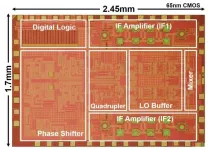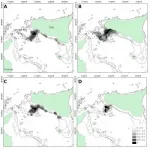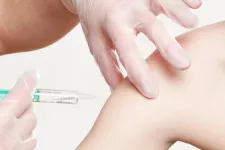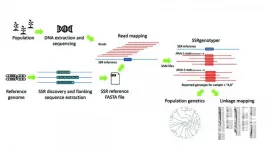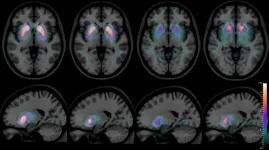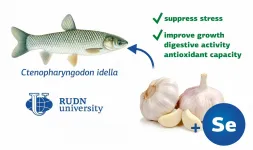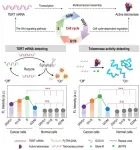Research establishes a new method to predict individual risk of cognitive decline
2021-02-05
(Press-News.org) The early prognosis of high-risk older adults for amnestic mild cognitive impairment (aMCI), using noninvasive and sensitive neuromarkers, is key for early prevention of Alzheimer's disease. A recent study, published in the Journal of Alzheimer's Disease, by researchers at the University of Kentucky establishes what they believe is a new way to predict the risk years before a clinical diagnosis. Their work shows that direct measures of brain signatures during mental activity are more sensitive and accurate predictors of memory decline than current standard behavioral testing.
"Many studies have measured electrophysiological rhythms during resting and sleep to predict Alzheimer's risk. This study demonstrates that better predictions of a person's cognitive risk can be made when the brain is challenged with a task. Additionally, we learned that out of thousands of possible brain oscillation measures, left-frontal brainwaves during so-called working memory tasks are good predictors for dementia risk," explained lead investigator Yang Jiang, associate professor of behavioral sciences and an affiliated faculty member at the Sanders-Brown Center on Aging.
When looking for a specific car in a large parking lot, older persons increasingly make more mistakes and take more time than young people due to brain and cognitive aging. Jiang says it has already been reported that brain waves associated with that type of daily memory task differ in cognitively normal older people and those of patients with memory loss and dementia. For this new study, researchers followed healthy older adults for 10 years. They reported that a specific pattern of frontal brainwaves during an everyday memory task predicts a person's risk of cognitive impairment roughly five years before clinical diagnosis. This pattern was not observed in older people who remained cognitively normal over the next 10 years.
Jiang says predicting and preventing cognitive decline is very important to allow preventive measures, such as life-style changes, and for researchers to help achieve a greater quality of life for the rapidly growing aging population. "Compared to current methods using neuroimaging as biomarkers, this method of measuring can be easily set up in clinics, is non-invasive, fast and affordable. Also, reliably predicting the risk of cognitive decline in an individual is new. Our older participants will soon be able to have better version of brainwave tests here at UK."
The clinical and translation work of this study was a team science effort with multiple investigators from UK's Sanders-Brown Center on Aging serving as coauthors including Erin Abner, Richard Kryscio, Greg Jicha, Fred Schmitt, Charles Smith, and collaborators from the Oak Ridge National Laboratory, University of Tennessee, and the Institute of Psychology, Beijing China.
This project was brought to SBCoA by scientists at the Oak Ridge National Laboratory co-author Nancy Munro to David Wekstein and Drs. William Markesbery and Charles Smith nearly 15 years ago with funding from the Department of Energy. The research team received funding from NIH in recent years to expand this work in large-scale and diverse populations. Jiang says their longitudinal study underscores the importance of having a successful Alzheimer's research center at UK.
Linda Van Eldik, director of the Sanders-Brown Center on Aging, said, "This further emphasizes the long-standing national and international reputation of UK's Sanders-Brown Center on Aging and the high quality of our investigators and the research they do."
INFORMATION:
Research reported in this publication was supported by the National Institute on Aging of the National Institutes of Health under Award Numbers K01AG00986, R56AG060608-01, and P30AG028383. The content is solely the responsibility of the authors and does not necessarily represent the official views of the National Institutes of Health. This material is based upon work supported by Oak Ridge National Laboratory and UT-Battelle LLC for the U.S. Department of Energy under Award Number DE-AC05-00OR22725. The content is solely the responsibility of the authors and does not necessarily represent the official views of the U.S. Department of Energy or Oak Ridge National Laboratory.
ELSE PRESS RELEASES FROM THIS DATE:
2021-02-05
Scientists at Tokyo Institute of Technology (Tokyo Tech) and NTT Corporation (NTT) develop a novel CMOS-based transceiver for wireless communications at the 300 GHz band, enabling future beyond-5G applications. Their design addresses the challenges of operating CMOS technology at its practical limit and represents the first wideband CMOS phased-array system to operate at such elevated frequencies.
Communication at higher frequencies is a perpetually sought-after goal in electronics because of the greater data rates that would be possible and to take advantage of underutilized ...
2021-02-05
A new study in Frontiers in Marine Science provides a first-of-its-kind evaluation of which regions of southern European seas are in the most need of fishing restrictions. These areas have persistently shown high numbers of undersized fish and crustaceans, which are typically discarded because they are below the allowable size limit for collection. These findings may offer a strategy for prioritizing conservation efforts and ensuring more sustainable fishery management in the future.
"Natural fish populations need time to reproduce and recover from fishing impacts -- this is the only way to achieve a balance between natural resources and human exploitation," says lead author Dr Giacomo Milisenda, of the Stazione Zoologica Anton Dohrn di Napoli in ...
2021-02-05
Multidisciplinary team of international experts suggests participants should receive a "substantial" amount, be paid ethically
Healthy people volunteering to be infected with SARS-CoV-2, in order to help scientists better understand how to tackle the virus, should receive payment - if it is determined that these studies are otherwise ethical to proceed.
Those are the findings of a new peer-reviewed study published in the American Journal of Bioethics, which has assessed the ethics of paying participants to take part in so-called 'Human Infection Challenge Studies' (HICS).
Over ...
2021-02-05
SSRgenotyper is a newly developed, free bioinformatic tool that allows researchers to digitally genotype sequenced populations using simple sequence repeats (SSRs), a task that previously required time-consuming lab-based methods.
Reporting in a recent issue of Applications in Plant Sciences, the tool's developers designed the program to seamlessly integrate with other applications currently used for the detection and analysis of SSRs.
Simple sequence repeats are short chains of repeating nucleotides that are prone to mutation. The variability of these DNA sequences makes them ideal for genetic analyses to distinguish between individuals and are often the marker of choice for paternity and forensic testing.
In research fields, SSRS have ...
2021-02-05
American actor Robin Williams had a neurodegenerative brain disease called dementia with Lewy bodies (DLB): a distressing disease, with symptoms in common with Alzheimer's disease (AD) and Parkinson's disease (PD). But unlike these two conditions, DLB also entails prominent mood and cognitive swings, sleep disorders, and vivid, sometimes terrifying, visual hallucinations. It is now thought that Robin Williams, whose diagnosis was only ascertained post-mortem, was likely driven to suicide, in 2014, by the terrifying hallucinatory experiences he suffered for years - and about which he never told anyone, not even his wife. Susan Schneider Williams recounted the tragic story in an editorial published in the journal ...
2021-02-05
As a new presidential administration takes steps to examine options to control the spread of COVID-19 through increased testing, epidemiologists at The University of Texas at Austin and other institutions have a new analysis that shows the value of having all people in the U.S. tested on a regular, rotating basis to slow the spread of the novel coronavirus and the loss of life from COVID-19. The team's model is outlined in a paper published online today in The Lancet Public Health.
With the introduction of accurate and inexpensive rapid tests, researchers say there is an optimal testing schedule that minimizes costs as well ...
2021-02-05
Weekly COVID-19 testing, with two-week isolation of positive cases, is the most cost-effective strategy to mitigate spread of the virus in the USA when transmission is high in affected areas until vaccines are widely available.
When transmission rates are low to moderate, monthly testing and a one-week isolation period is the most cost-effective approach.
Monthly population testing is more cost-effective than the current strategy of testing only people showing symptoms and their close contacts.
Weekly COVID-19 testing, coupled with a two-week isolation period for positive cases, may be the most cost-effective strategy to tackle the ...
2021-02-04
A biologist from RUDN University confirmed that selenium nanoparticles and garlic extract can effectively reduce the negative impact of stress on the health of grass carp in the breeding industry. The results of his study were published in the Journal of the World Aquaculture Society.
Grass carp or Ctenopharyngodon Idella is a valuable commercial fish type. In order to increase productivity, fish farms tend to breed more and more fish in small reservoirs. This extreme population density causes stress in carps that negatively affects their health, namely, reduces immunity, slows down growth, suppresses digestion, and interferes with intestinal functions. To mitigate ...
2021-02-04
Cancer is a significant cause of death worldwide and many efforts have been devoted to the development of methods for early detection. Telomerase are considered as a tumor biomarker for early diagnosis because the telomerase of more than 80% immortalized cells are reactivated and provides the sustained proliferative capacity of these cells, but the telomerase activity are not detectable in normal somatic cells. Telomerase is a ribonucleoprotein complex that is thought to add telomeric repeats onto the ends of chromosomes during the replicative phase (S ...
2021-02-04
DETROIT - Wayne State University School of Medicine researchers have reported that zinc supplements for men and women attempting to conceive either naturally or through assisted reproduction during the COVID-19 pandemic may prevent mitochondrial damage in young egg and sperm cells, as well as enhance immunity against the virus.
In "Potential Role of Zinc in the COVID-19 Disease Process and its Probable Impact on Reproduction," published in Reproductive Sciences, Husam Abu-Soud, Ph.D., associate professor of Obstetrics and Gynecology and the C.S. Mott Center for Growth and Development, ...
LAST 30 PRESS RELEASES:
[Press-News.org] Research establishes a new method to predict individual risk of cognitive decline
